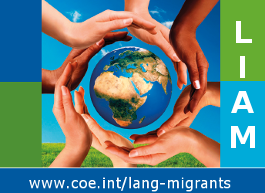Scenarios in language teaching and learning for adult migrants
The situations in which migrants and those in refugee-like situations find themselves can range, depending on their circumstances, from an urgent concern for practical issues of everyday life, such as finding somewhere to live or to stay temporarily or getting urgent medical attention, to finding a school for a child or being interviewed for a job once they are settled in a destination country. Such situations, and many others that are relevant to migrants’ lives, can form the basis of language learning ‘scenarios’.
The word ‘scenario’ can be used to describe everyday activities related to the real world, such as using public transport, going to the cinema, renewing a passport etc. Each scenario comprises a series of verbal and non-verbal actions involving both general knowledge (e.g. where to by a bus ticket) and competences (such as filling out a form) that are designed to lead to successfully carrying out the activities in question.
In language learning, scenarios enable language learners to practise using the target language in a realistic but simulated way or, in informal learning, as genuine communication. Such scenarios are useful because, as discussed in the Core Inventory for General English (British Council/Eaquals 2010), they provide a mental framework for the way a particular situation or set of situations is typically dealt with in a given target language and social context. “[…] a scenario suggests a holistic setting that encourages the integration of different aspects of competence in real [or realistic] language use” (p.13). Scenarios of this kind can help when analysing migrants’ communicative and language learning needs, and can provide a basis for organising language teaching for adult migrants. Scenarios were used in these ways in the 1970s, for example in Colombier and Poilroux (1977), and more recently in Beacco et al. (2005, especially pages 54-56).
As scenarios are sequences of communicative situations, they offer a means of incorporating Common European Framework of Reference for Languages (CEFR) descriptors into language learning. A CEFR-based scenario provides a set of real-world variables, including a domain, context, tasks, language activities and texts (see CEFR, pp.13-14), in which “Can-Do” descriptors can be integrated as learning objectives, together with aspects of strategic, pragmatic and linguistic competence as enabling objectives, and quality criteria for evaluation purposes.
The example in the appendix, which follows the format proposed the Core Inventory for General English and the Inventaire linguistique des contenus clés aux niveaux du CECR (CIEP/Eaquals 2015), shows how this can be done at a very simple level when enabling learners with elementary proficiency in the target language (in this case, English) to practise and improve the language they need to travel from one location to another in a new country or city. Scenarios like this can be developed by the institution providing courses or by teachers themselves. Such scenarios outline the domains (in the example, personal and public), the contexts (the kinds of places and people concerned), the tasks that are likely to need to be performed using language, and the kinds of language, or ‘texts’, that need to be dealt with.
A different and much more comprehensive approach to developing scenarios is to be found in the fide project, instigated by the Swiss Federal Migration Office in order to support the language courses offered to migrants in Switzerland. The project, which has developed materials in the three main languages of Switzerland, French, German and Italian, aimed to create both carefully structured resources for those providing language courses for migrants and a sound framework for assessing migrants’ communicative competence. The resources, many of them available online via the fide website, are built around typical scenarios in 11 key areas, such as health, looking for work, housing, transport and administration. For example, in the area of housing, one of the scenarios is introducing oneself to neighbours. Short model videos are available to help bring the scenarios to life.
The Core Inventory for General English summarises the advantages of such scenarios: “The significant point about CEFR-based scenarios is that they offer teachers and learners a way of keeping in mind both the macro vision of successful real communication and the micro focus on specific practice points. Scenarios are a tool for defining, teaching and/or assessing the competences needed to perform real world tasks” (p.13).
RR
Related resources
Beacco J, M. De Ferrari, G. Lhôte, & C. Tagliante (2005). Niveau A1.1 pour le français : référentiel de certification (DILF) pour les premiers acquis en français. Paris : Didier
British Council/Eaquals (2010). The British Council-Eaquals Core Inventory for General English. London: The British Council – accessible at http://englishagenda.britishcouncil.org/sites/ec/files/books-british-council-eaquals-core-inventory.pdf and https://www.eaquals.org/resources/the-core-inventory-for-general-english/
CIEP/Eaquals (2015). Inventaire linguistique des contenus clés aux niveaux du CECR. Sèvres: CIEP – available to view at http://www.ciep.fr/sources/ressources/inventaire-linguistique-des-contenus-cles-des-niveaux-du-cecrl/ ; accessible at https://www.eaquals.org/resources/inventaire-des-contenus-cles-aux-niveaux-du-cecr/
Colombier, P., & J. Poilroux (1977). ‘Pour un enseignement fonctionnel du français aux migrants’ (‘Towards functional teaching of French to immigrants’). Le Français dans le monde, 133, 21-28.
Council of Europe (2001). The Common European Framework of Reference for Languages. Learning, Teaching, Assessment. Cambridge: Cambridge University Press. www.coe.int/lang-CEFR
fide project – website in 4 languages. see Flyer and Presentation at a Council of Europe Conference (French only)



